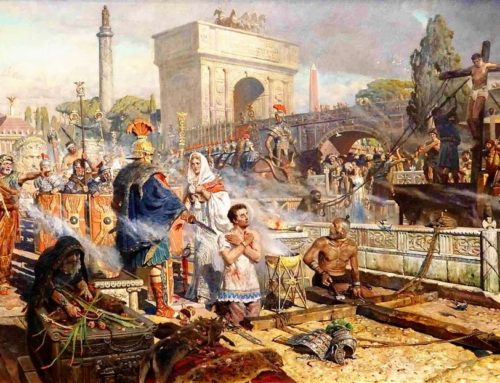There are more than sixty catacombs in Rome, with hundreds of miles of galleries and tens of thousands of tombs. Catacombs are found also at Chiusi, Bolsena, Naples, in eastem Sicily and in North Africa too. The system of underground digging was not the invention of the Christians, nor was it caused by the persecutions. The catacombs were simply Christian collective burial grounds, dug out in the depths of the earth.
The Christians adopted a preexisting technique of excavation and developed it on an immense scale into a vast and multi-levelled network of galleries. This was the solution to the problems of burial of a large community with an ever increasing number of members. The speedy and enormous development of some catacombs was also due to the cult of the martyrs buried there. Many Christians insisted on having a tomb as close as possible to the venerated graves of the martyrs, in order to secure their intercession.
The catacombs are visited to-day by thousands of pilgrims from all over the world, because of their importance. The catacombs with their precious patrimony of paintings, inscriptions, sculptures, etc., are considered the authentic archives of the primitive Church, which document her usages and customs, her rites and beliefs and the Christian doctrine, as it was understood, taught and practised in that time.
The early Christians did not bury their faith nor their lives in the underground, but lived common people lives in their families, in society, in all activities, jobs and professions. They testified their faith everywhere, but it was in the catacombs that those heroic Christians found the strength and support to face the trials and persecutions, as they prayed to God through the martyrs’ intercession.
The Christians of the first centuries bore a wonderful witness to Christ; many of them even by the shedding of their blood, so that martyrdom has become a glorious mark of the Church.
Despite the fact that the catacombs are, after all, only cemeteries, they speak to the mind and heart of the visitors in a silent and understandable language. In the catacombs everything speaks of life more than death. Every gallery they pass through, every symbol or painting they see, every inscription they read, brings the past to life and gives a message of faith and of Christian testimony.
Therefore the visit to the catacombs cannot be reduced to a mere sightseeing tour neither to a cultural archaeological trip. Following the example of the numberless pilgrims of the past, it should turn out to be an authentic pilgrimage of faith to one of the historical monuments that better expresses the life and martyrdom of the Roman Church of the first centuries.




Leave A Comment
You must be logged in to post a comment.